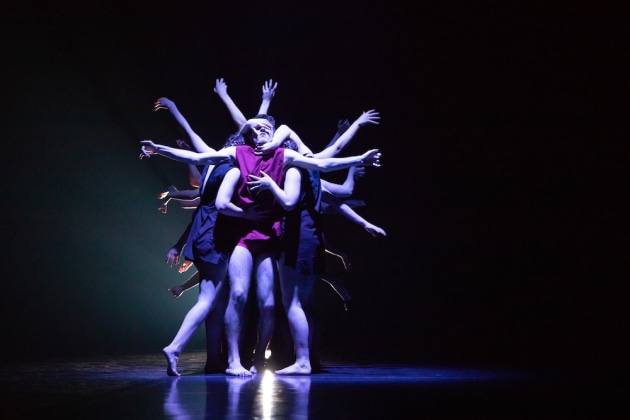Gardens Theatre, QUT, 29 October
Looking back over the past twelve or so Queensland University of Technology (QUT) Dance graduation seasons, there has been little change in the programming format. Again this year, the third year graduating students were featured prominently, performing three of the five short works. And as in most previous years, it was a small cohort of only five graduating dancers, with, disappointingly, only two male students across the entire program.
Created collaboratively with the first year students, Oneself One’s Self, by Elise May, is a visually beautiful work that explores the notion of the self-portrait, from the traditional visual art perspective, but also the distorts realities of digitally constructed identities on social media.
An iridescent blue lighting design by Glen Hughes, and the large, slow moving, head and shoulders image, by animator Jordan Turner, make this a visually compelling work. The dancers, performing mainly behind a back-lit gauze, reflect splinters of the light as they manipulate hand-held squares of mirror in the early moments.
The work opens strongly as the dancers group and regroup with an undulating, writhing movement, reflecting the dancers’ movement vocabulary. But, as they only occasionally break away to emerge in front of the gauze, the work develops little beyond those compelling opening moments.

Visceral Tides, by Lina Limosani was the final work of the program, choreographed for the cohort of fifteen second year students. It explores the vicissitudes of relationships – their ebb and flow, and connection and disconnection, which are clearly explored by pulsating movement that has a clear focus on the arms and torso, effectively moving from the mesmerisingly calm to the volatile.
The sudden appearance of a dancer (Lachlan Doherty), bare chested and in red pants, as an antagonistic force, jerks the work towards a satisfying conclusion as the other dancers, creating an amorphous mass of bodies, “consume” him.
In spite of the rather unflattering black tunic-like costumes, and a first section that was a little long, Visceral Tides was a strong finish to the program.
The third year graduating students opened with Gaps, Lapse and Relapse, a work by the late Jeremy James, created for Rambert in 1998, and restaged here by Elizabeth Old, an original cast member. The score by Peter Morris effectively underpins a tightly constructed work of staccato, jerky and angular movement, with repeated twisting of the upper body, and a rather mechanically driven style. It requires the maintenance of a raw enthusiasm to be effective and the cast, in jeans and t-shirts, lost that a little in the middle section.

Steph Hutchison’s Neural Dust was the final work for the third years. Exploring the “nature of technologising the body,” it begins with a solo dancer seemingly constrained under an overhead spot, centre stage, against a soundscape of heavy, distressed breathing. The extensive use of laser lighting begins with a diagonal neon blue barb cutting high through the space, and develops into a spectacular display of multiple coloured beams radiating from upstage to the back of the auditorium. It becomes particularly effective when the dancers, in black, interact with the rays of laser light.
Deeper Than Ink – Amy Hollingsworth’s dense, rather dark exploration of the exhilarating, all consuming, and occasionally debilitating power of love – was the second and most effective work for the third years. Hollingsworth’s keen eye for cohesion of movement, light and sound was apparent, while costumes of loose black pants over white leotards, with “ink” on parts of the dancers’ arms and throats, also tied in thematically.
Lighting punctures the inky black space to effectively capture various amorphous formations of the dancers’ bodies in the work’s early moments. The movement is sinuous, abandoned at times, but it always describes anguish, fear and hope with originality and clarity. It was a highlight of the evening’s program.
– DENISE RICHARDSON




